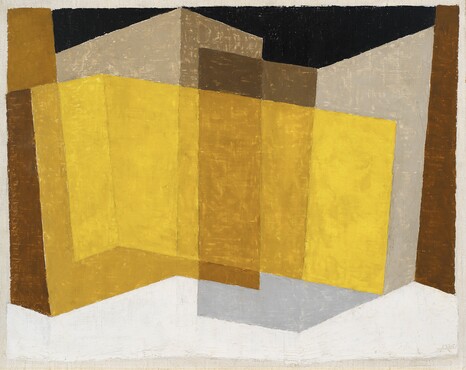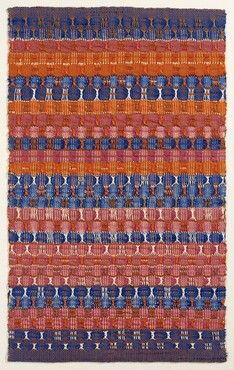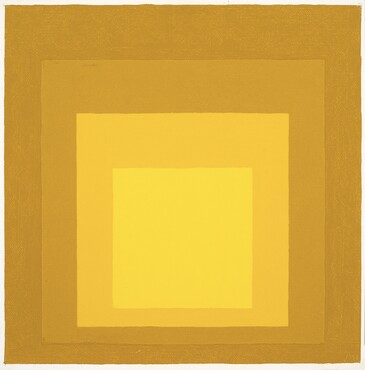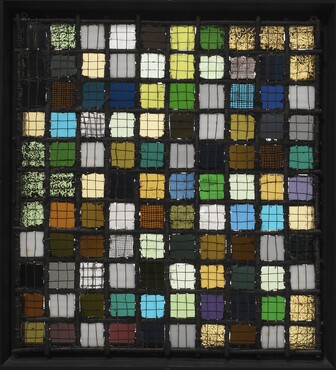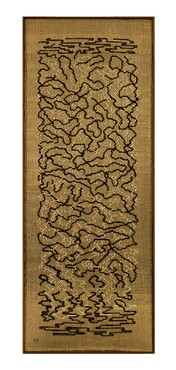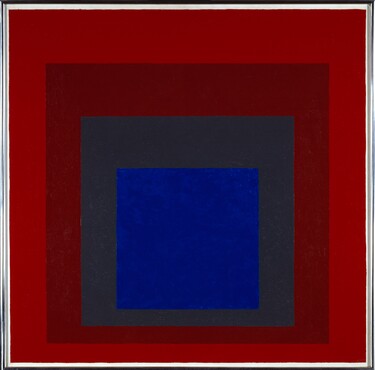Ontdek de collectie
Kunstmuseum Den Haag has a treasure chamber of over 160.000 pieces of art. Here we work on making the highlights from this collection available online.
Anni and Josef Albers
Kunstmuseum Den Haag presents the first exhibition ever in the Netherlands to examine the life and work of Anni and Josef Albers. The art and inspiring teachings of this famous artist couple had an inestimable impact on the development of modern art.
Featuring over 200 works - including textiles, paintings, graphic art, photographs, furniture and drawings - this exhibition shows how Anni Albers (1899 -1994) evolved into a true pioneer of modern textile art, and highlights the process of artistic development Josef Albers (1888-1976) underwent which culminated in his internationally renowned Homage to the Square series which comprises innumerable colour studies in a square format.
These two European artists, who were born in Germany just before the turn of the 20th century, originally discovered the richness of South America’s ancient cultures while in the U.S.A. As teachers, they tried to convey to their students the cultural importance of the various utilitarian objects and artistic treasures produced by the cultures they revered. At the same time, those cultures continued to profoundly influence their own art. The rich textile traditions deepened Anni’s knowledge and ideas, while Josef’s compositions were inspired by the architecture of Mexico and Peru.
Josef and Anni met at the acclaimed Bauhaus in 1922. It was there that they developed a lifelong personal and professional relationship. The couple married soon afterwards, and as the Nazis rose to power, they decided to flee Germany and continue their lives as artists and teachers in the United States.
Anni Albers: Founder of Modern Textile Art
At the start of her training, like most women at the Bauhaus, Anni Albers was forced to focus on weaving. She reluctantly complied, but once she found herself in the textile workshop her disappointment quickly transformed into great enthusiasm for the versatility of the medium. She experimented with various techniques, introducing weaving patterns as an explicit element of her compositions, and combined jute and cotton yarn with metal thread or synthetic material like cellophane. With her unconventional use of materials, her innovative style and her efforts to achieve recognition of weaving as a visual art, Anni Albers became one of the founders of the modern textile art movement.
Josef Albers: the impact of colour
Josef Albers devoted his working life to studying the physical and emotional impact of colour, initially producing geometric compositions in sandblasted glass. Later in his paintings he developed a unique abstract idiom that is all about the visual interaction of colours. These experiments eventually led to his now-famous series of paintings and graphic works entitled Homage to the Square, a seemingly endless serious of harmonious colour combinations.
Teaching
Josef and Anni Albers continued teaching to an advanced age at various educational establishments. Josef described their main ambition as teachers as being able ‘to open eyes’. They encouraged new generations to open their eyes to the wonders around them: from nature to culture, form to colour. Their former students, fellow teachers and other close contacts include famous names like sculptor Ruth Asawa, dancer Merce Cunningham, composer John Cage, and painter Robert Rauschenberg.
Exhibition
In order to illustrate the versatility of the work of Anni and Josef Albers, Kunstmuseum Den Haag currently has a collection of some 200 works on display. This selection features some of the finest work by both artists, displayed both chronologically and thematically, starting with their own training at the Bauhaus, their departure for the revolutionary Black Mountain College in the United States, the inspiration they drew from pre-Columbian culture and finally their own enduring impact on modern art.
This exhibition also shows how the life and work of this artist couple are closely interwoven. Although they both worked with different materials, they shared the same attitude to life, plus the same artistic vision, curiosity about the unknown and sources of inspiration. They both focused on experimentation, and the challenge of creating the most innovative compositions on the basis of self-imposed restrictions in terms of colour, form or use of materials.
Inspired by Pre-Columbian Culture
The museum also focuses considerable attention on the influence of pre-Columbian culture on the work of both Anni and Josef Albers. During trips to countries like Mexico, Chile and Peru they discovered the beauty and quality of the cultures of long-gone civilisations that existed before European colonisation. Besides showcasing the clear influence on their work, the museum also displays several examples of ancient pre-Columbian sculptures as well as textile fragments from the Albers’ personal collection.
Catalogue
A catalogue has been published to accompany the exhibition. Published by WBOOKS, the catalogue numbers over 200 pages, including contributions from Frouke van Dijke, Willem van Roij, Nicholas Fox Weber and Caro Verbeek - and designed by Typography Interiority and Other Serious Matters. The catalogue is now available, at the price of EUR 34.95.
Tentoonstelling
Om de veelzijdigheid van de oeuvres van Anni en Josef Albers in beeld te brengen brengt Kunstmuseum Den Haag een verzameling van circa 200 werken samen. De selectie bestaat uit topstukken uit het oeuvre van beide kunstenaars, die chronologisch-thematisch worden getoond, beginnende bij hun vormende opleiding aan het Bauhaus, hun vertrek naar de revolutionaire opleiding Black Mountain College in de Verenigde Staten, de inspiratie die zij vonden in de precolumbiaanse cultuur en hun blijvende impact op de moderne kunst.
De tentoonstelling toont ook aan hoe het leven en werk van dit kunstenaarskoppel nauw met elkaar is verbonden. Hoewel ze beiden werken met verschillenden materialen, delen ze dezelfde levenshouding, artistieke visie, nieuwsgierigheid naar de ander en inspiratiebronnen. Centraal staat het experiment, en de uitdaging om aan de hand van zelfopgelegde beperkingen op het gebied van kleur, vorm of materiaalgebruik te komen tot de meest innovatieve composities.
Precolumbinaanse cultuur als inspiratiebron
Daarnaast besteedt het museum uitgebreid aandacht aan de invloed van de precolumbiaanse cultuur op het werk van zowel Anni als Josef Albers. Dankzij hun reizen naar landen als Mexico, Chili en Peru ontdekt het echtpaar de schoonheid en kwaliteit van de cultuur van lang verdwenen beschavingen van voor de Europese kolonisatie. Naast de aantoonbare invloed op hun werk toont het museum ook enkele voorbeelden van eeuwenoude precolumbiaanse sculpturen en textielfragmenten uit de privéverzameling van het echtpaar Albers.
Catalogus
Bij de tentoonstelling verschijnt een catalogus. De publicatie telt ruim 200 pagina’s en wordt uitgegeven door WBOOKS, met bijdragen van Frouke van Dijke, Willem van Roij, Nicholas Fox Weber en Caro Verbeek. De vormgeving is van Typography and Other Serious Matters. De catalogus is vanaf oktober beschikbaar voor 34,95 euro.
The exhibition has been created in close collaboration with The Josef and Anni Albers Foundation.

